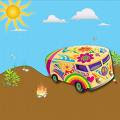
This December marks the 40th anniversary of “Frosty the Snowman,” a thirty-minute animated television special based on the popular song of the same title. The program first aired on December 14, 1969 and was produced by Rankin-Bass and featured the voices of comedians Jimmy Durante as narrator and Jackie Vernon as the title character. Although this special originally aired in 1969, in 1970 several edits were made, including the addition of a yellow-and-orange checkerboard scarf to Frosty's neck and the replacement of June Foray with uncredited voice of Karen.
“Santa Claus Is Comin' to Town” (1970) is a stop motion television special, made by Rankin-Bass with models carved from wood. The film stars actor Fred Astaire as S.D. Kluger, the narrator, and Mickey Rooney as Kris Kringle/Santa Claus, and tells the story of how Santa Claus and several Claus-related Christmas traditions came to be. It is based on the Christmas song of the same name, which was introduced on radio by Eddie Cantor in 1934.

“The Waltons: The Homecoming: A Christmas Story” (1971) is the movie that introduced America to Walton Mountain and the Walton family as they struggled to make a decent life during the Great Depression and World War II. This movie leads to the heartwarming family series “The Waltons” which ran for almost a decade.
“Twas the Night Before Christmas”(1974) is a Rankin-Bass animated Christmas television special based on the famous 1823 poem by Clement C. Moore and revolves around a family of mice who try to restore Christmas.
“The Year Without a Santa Claus” (1974) is another Rankin-Bass stop motion animated television special. This is a Claymation story about Santa deciding to take a holiday one year - Mrs. Claus corrals Heat Miser and Snow Miser, along with children of the world to show Santa people still believe in him. It is based on Phyllis McGinley's 1956 book of the same name.
“Yes, Virginia, there is a Santa Claus” (1974) is an animated account of young Virginia O'Hanlon's letter to the editor inquiring on the truth of Santa Claus. “Nestor, The Long-Eared Christmas Donkey” (1977) is a Christmas television special produced in stop motion animation by Rankin-Bass and is narrated by Santa Claus's donkey, Speiltoe, voiced by Roger Miller.

“Little House on the Prairie: Christmas at Plum Creek” (1974) is of course, the story of the Ingalls family, a TV series during the 1970s. With Christmas approaching and the Ingalls facing a very short supply of shopping money, everyone works hard to make the holidays special. “Little House on the Prairie: Blizzard” (1976) is another favorite for the holidays. On Christmas Eve, the schoolchildren's holiday-induced excitement prompts Miss Beadle to release them early. This proves to be a grave mistake when a brewing snowstorm peaks before the children have had time to return home.
There are so many different Christmas specials and programs throughout the holiday season and I’m sure every family has their favorites. With the Christmas season upon us, why not have a family movie night and watch some of these classic shows? It will make memories your family will remember forever.






































